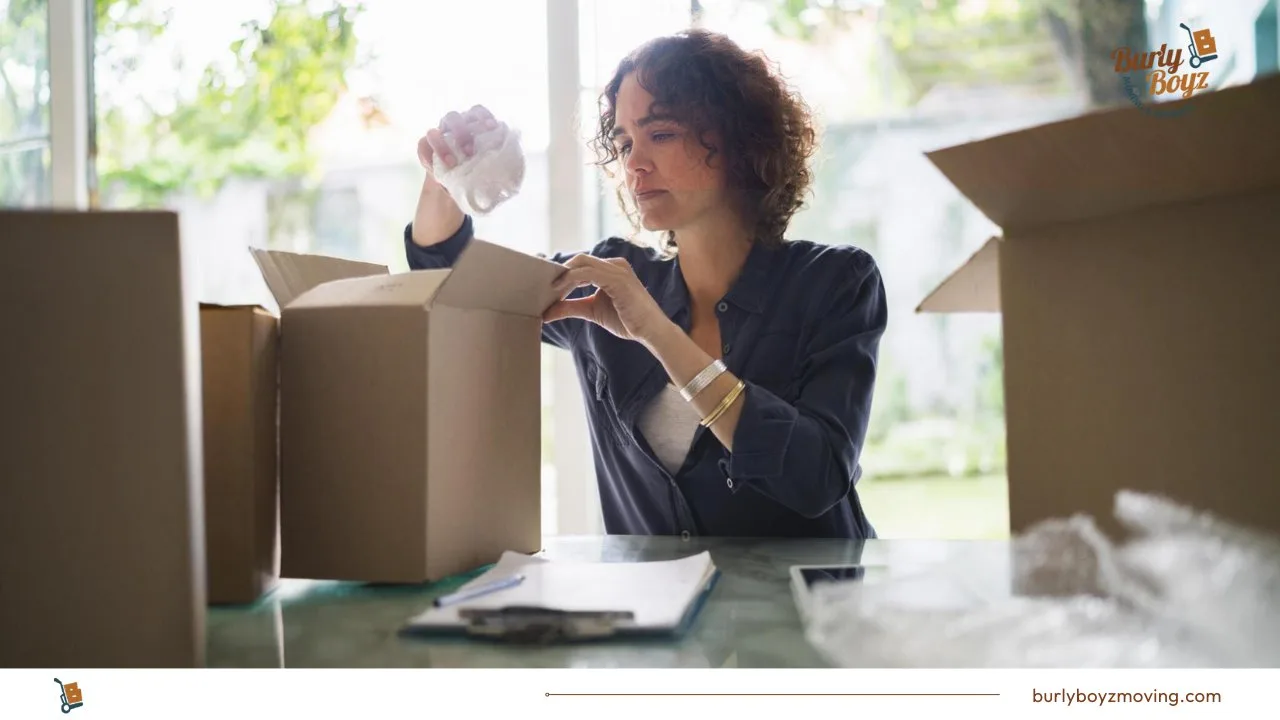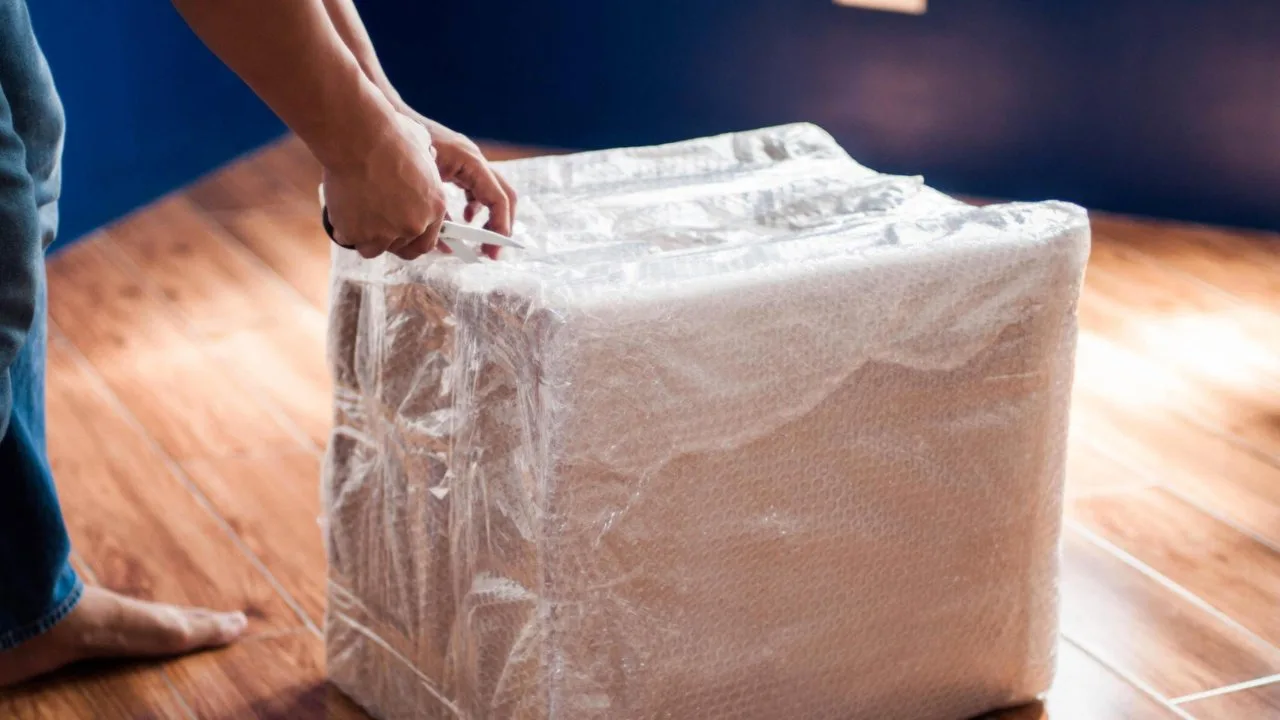
One of the decisions you’ll face when moving involves choosing suitable packing materials to protect your cherished belongings. The debate between packing paper and bubble wrap is common, each offering unique advantages for safeguarding different types of items during transit.
In this blog post, we’ll focus on the specifics of both materials, helping you make an informed decision that ensures your items arrive at their new home in pristine condition. Whether moving delicate heirlooms or sturdy kitchenware, understanding the nuances of packing paper and bubble wrap is essential.
For those seeking a seamless, worry-free moving experience across Canada, look no further than Burly Boyz. With our expertise and comprehensive moving services, we’re here to support all your moving needs, ensuring every item is packed with the utmost care.
Packing Paper For Moving vs. Bubble Wrap
Packing paper and bubble wrap are two of the most popular options, each with benefits and best uses. Let’s compare packing paper and bubble wrap across three key factors: protection level, cost-effectiveness, and environmental impact.
Protection Level
- Packing Paper: Packing paper offers a moderate level of protection, primarily against scratches and minor impacts. It’s particularly effective for wrapping, filling up empty spaces in boxes, and cushioning manageable items, such as books, kitchenware, and clothing. Its ability to wrap tightly around objects also makes it helpful in protecting the surfaces of more delicate items like glassware and dishes. However, it may not prevent breakage if the item is significantly impacted.
- Bubble Wrap: Bubble wrap provides superior protection to packing paper, thanks to its air-filled bubbles that absorb shocks and impacts. This makes it the preferred choice for highly fragile or valuable items like electronics, antiques, and fine china. The cushioning effect of bubble wrap is unmatched, offering peace of mind that your items will arrive at their destination intact, even when they’re subjected to roughness during transport.
Cost-Effectiveness
- Packing Paper: Generally, packing paper is more cost-effective than bubble wrap. It’s sold in large sheets or rolls that can cover much ground with relatively little material. Because it’s lightweight and thin, you can pack more items with less paper, making it a budget-friendly option for wrapping many items or filling empty spaces in boxes.
- Bubble Wrap: Bubble wrap tends to be more expensive per square foot than packing paper. Its cost is justified by the higher level of protection it offers, especially for items that are irreplaceable or prone to damage. However, for moves where every penny counts, using bubble wrap selectively for only the most fragile items and supplementing with packing paper for less delicate belongings can be a more cost-effective strategy.
Environmental Impact
- Packing Paper: Packing paper scores highly in terms of eco-friendliness. It’s often made from recycled materials and is fully recyclable, making it a sustainable choice for environmentally conscious movers. The ease of recycling packing paper through curbside programs also adds to its environmental appeal.
- Bubble Wrap: Bubble wrap has a larger environmental footprint than packing paper. While it can be reused multiple times if handled carefully. Not all recycling programs accept bubble wrap, and it’s made from plastic, which takes significantly longer to decompose in landfills than paper.
Making the Right Choice for Your Move
Choosing suitable packing materials is essential for a successful move. It not only ensures the safety of your belongings but can also significantly reduce stress and waste.
Assessing Your Packing Needs
Before packing, thoroughly inventory your items to determine the best packing strategy. Here are some steps to help you assess your needs:
Categorize Your Items: Divide your belongings into categories based on fragility, size, and value. Fragile items require more protection, potentially needing bubble wrap, while less delicate items can be safely packed with packing paper.
Evaluate Item Surfaces: Consider the surface of each item. Smooth, hard surfaces, such as dishes and glassware, are well-suited to packing paper, which can prevent scratches and dust. Textured or irregularly shaped items benefit from the cushioning effect of bubble wrap.
Consider Move Distance and Mode: The length and complexity of your move can influence your choice of materials. Long-distance moves or shipping may require more robust protection like bubble wrap, whereas packing paper might adequately serve local moves.
Combining Packing Materials for Optimal Protection
Using a combination of packing paper and bubble wrap can offer the best protection for your belongings. Here’s how to integrate both materials effectively:
Layering: Start with a layer of packing paper for initial protection, especially for items stained or damaged by direct contact with bubble wrap. Then, add a layer of bubble wrap for enhanced cushioning and shock absorption.
Securing Loose Items: Use packing paper to fill gaps in boxes or wrap individual, smaller items before placing them in a box lined with bubble wrap. This technique prevents movement and provides double protection against impacts.
Protecting Edges and Corners: For items with sharp edges or fragile corners, wrap these areas with bubble wrap after covering the item with packing paper. This approach targets protection where it’s most needed.
Tips for Efficient Packing
Efficient packing saves time and reduces the amount of packing material needed, cutting down on waste and costs. Here are some tips to pack efficiently:
- Use the Right Size Boxes: Choose boxes that closely match the size of the packed items. This minimizes the need for excess packing material and makes loading more straightforward.
- Create a Packing Station: Set up a designated area with all your packing materials. This organization can streamline the packing process and reduce the time spent searching for supplies.
- Reuse Materials Where Possible: If you have bubble wrap or packing paper from previous moves, inspect them for wear and reuse if they’re still in good condition. This approach is both cost-effective and environmentally friendly.
- Label Clearly: Mark boxes with their contents and the room they belong to. This practice makes unpacking easier and helps you determine the level of protection needed for each box during the move.
Understanding Packing Paper
Packing paper is a staple in the moving industry, known for its versatility and efficiency in protecting items during transit.
What is Packing Paper?
Packing paper is a clean, ink-free paper, typically made from recycled materials, used in the packing process to protect items from scratches, dust, and minor impacts.
Unlike newspaper or printed materials, packing paper is designed specifically for moving and storage, ensuring that items remain clean and free from ink transfer.
Typical uses of packing paper in moving include wrapping dishes, glasses, and other fragile items, filling empty spaces in boxes to prevent shifting, and providing a cushioned layer between stacked items.
Benefits of Packing Paper
Packing paper offers several advantages that make it a preferred choice for both professional movers and DIY packers:
- Affordability: Packing paper is a cost-effective packing material. Its efficiency means using less material to protect your items, stretching your moving budget further.
- Flexibility: Its pliable nature allows it to wrap tightly around items of any shape, providing a snug, protective layer that helps prevent damage during movement.
- Eco-friendliness: Most packing paper is made from recycled materials and is fully recyclable, making it an environmentally responsible choice for the eco-conscious mover.
- Cleanliness: Being ink-free, packing paper won’t leave behind stains or marks, ensuring your items arrive at your new home in the same condition they left.
Ideal Uses for Packing Paper
While packing paper is incredibly versatile, it is particularly well-suited for protecting certain types of items during a move:
- Dishes and Glassware: Its ability to wrap snugly around individual pieces makes it perfect for protecting fragile items like plates, bowls, glasses, and stemware, preventing scratches and reducing the risk of breakage.
- Small Appliances and Electronics: Packing paper can wrap and cushion small appliances and electronics, protecting them from dust and minor impacts.
- Decorative Items and Collectibles: For items with intricate designs or delicate surfaces, packing paper offers a safe wrapping solution that can be layered for additional protection.
- Filler Material: Beyond wrapping, packing paper is excellent for filling voids in boxes, preventing items from shifting and colliding during transport. This use is crucial for ensuring that even non-fragile items remain secure.
Packing paper’s attributes—affordability, flexibility, and eco-friendliness—alongside its effectiveness in protecting a wide range of items make it an indispensable resource in any move.
Whether packing up a full household or preparing a single fragile item for shipping, packing paper provides a reliable layer of protection to ensure your belongings arrive safely at their destination.
Understanding Bubble Wrap

Bubble wrap provides greater protection to your fragile belongings. Known for its distinctive design of air-filled bubbles, this material offers extra cushioning and protection for items in transit.
What is Bubble Wrap?
Bubble wrap is a pliable, transparent plastic material for packing and safeguarding fragile items during moves or shipping. It consists of numerous small air pockets, or bubbles, that provide cushioning and absorb shocks and impacts.
Common uses of bubble wrap include wrapping breakable items, filling voids in boxes to prevent item movement, and wrapping items for long-term storage to protect against dust, moisture, and environmental damage.
Benefits of Bubble Wrap
The use of bubble wrap in packing offers several significant advantages:
- Superior Protection: The air-filled bubbles are designed to absorb and distribute the impact over a larger area, reducing the risk of damage to the item inside.
- Cushioning for Fragile Items: Bubble wrap is ideal for protecting items especially prone to breakage, such as glassware and electronics, providing a soft cushion that guards against bumps and drops.
- Versatility: Bubble wrap can be used to protect items of almost any shape and size. Its flexibility allows it to wrap snugly around objects, ensuring thorough protection.
- Lightweight: Despite offering excellent protection, bubble wrap is very lightweight, which helps keep shipping costs down.
- Reusability: Bubble wrap can often be reused for future moves or storing items, making it more eco-friendly than single-use packing materials.
Ideal Uses for Bubble Wrap
While bubble wrap is versatile enough to protect a wide range of items, it is particularly well-suited for certain applications:
- Highly Fragile Items: Items especially prone to breaking, such as ceramics, glass items, and fine china, benefit significantly from bubble wrap’s cushioning effect.
- Valuable Items: For antiques, collectibles, and high-value electronics, bubble wrap provides peace of mind by offering a higher level of protection against damage.
- Electronics: The air pockets in bubble wrap can protect electronic items from shocks and static, making it ideal for packing computers, TVs, and other sensitive equipment.
- Irregularly Shaped Items: Its flexibility makes bubble wrap perfect for wrapping items with odd shapes or protruding parts that might be damaged or cause damage to other items.
- Long-Distance Moves: For items traveling long distances or being shipped, bubble wrap’s durable protection is particularly important to safeguard belongings against increased handling and shifting.
Bubble wrap’s combination of superior protection, cushioning, and versatility makes it an essential packing material for anyone looking to protect their belongings from the rigors of moving. Its ability to safeguard the most fragile and valuable items through any move, big or small, has cemented its place as a go-to resource in packing and moving.
